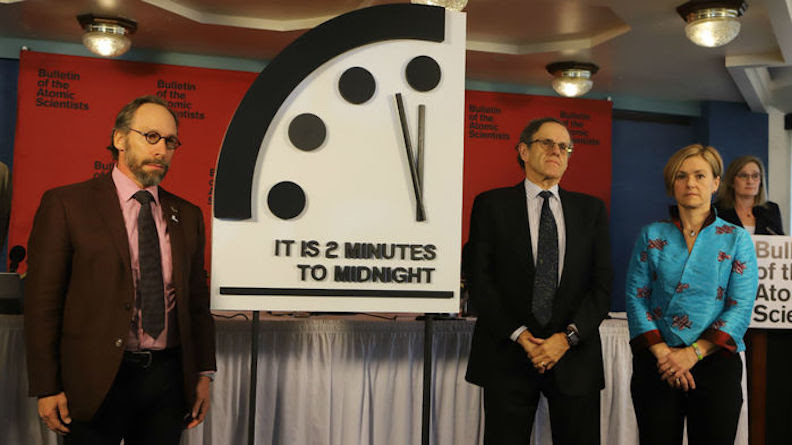
The world is closer to nuclear annihilation than at any point since the first hydrogen bombs were tested in the early 1950s, says a group of scientists who monitor global tensions. The Bulletin of the Atomic Scientists announced that it has moved its Doomsday Clock to 2 minutes before midnight, citing North Korea’s recent tests of missiles and nuclear weapons and the world’s lack of progress in confronting climate change. The change is the closest ever that the clock has been to midnight.
“In 2017, we saw reckless language in the nuclear realm heat up already dangerous situations and relearned that minimizing evidence-based assessments regarding climate and other global challenges does not lead to better public policies,” said Rachel Bronson, the Bulletin’s president and CEO in Chicago, Illinois. Last year the clock moved half a tick, from 3 minutes to 2.5 minutes before midnight; it has been in single digits since India and Pakistan staged back-to-back nuclear weapons tests in 1998.
In addition to a war of words between U.S. President Donald Trump and North Korean leader Kim Jong-un, the Bulletin’s Science and Security Board flagged steps by all of the world’s nuclear powers to enhance their nuclear arsenals. The lack of high-level negotiations between the United States and Russia on arms control, Russia’s activities in Crimea, and plans to strengthen the U.S. nuclear arsenal have also heightened tensions, said Sharon Squassoni, a board member and international affairs expert at The George Washington University in Washington, D.C. “With U.S.-Russian relations so strained, there is little room for progress anywhere else,” she noted at a press briefing.
The Bulletin scientists said worsening effects from climate change have also increased the risk of global annihilation, citing destructive hurricanes in the Caribbean, heat waves around the globe, wildfires in the United States and Canada, rising greenhouse gas emissions and declining Arctic ice cover.
Are things today as bad as in 1953, when both the United States and Russia exploded thermonuclear bombs? Comparisons are difficult, Bronson says, but there are more nuclear weapon states today than in the 1950s. “We’ve made the clear statement that we feel the world is getting more dangerous… We present the clock not so much as doom and gloom, but as an opportunity to get government and the public discussing the important issues,” adds physicist Lawrence Krauss of Arizona State University in Tempe.
In a Doomsday Clock report by the Bulletin scientists suggests ways world leaders can step back from the brink, starting with Trump ignoring Kim Jong-un’s provocative rhetoric. But because leaders and governments have proved ineffective at easing many threats, says Sivan Kartha of the Stockholm Environment Institute, moving the clock back will require the public to “compel their leaders to once again respect scientists, heed the facts, and make rational choices that move us further from the brink.”
“And there shall be… upon the earth distress of nations, with perplexity; the sea and the waves roaring. Men’s hearts failing them for fear, and for looking after those things which are coming on the earth: for the powers of heaven shall be shaken.” Luke 21:25, 26.
Source References
Scientists’ Doomsday Clock reaches 2 minutes to midnight, closest ever
